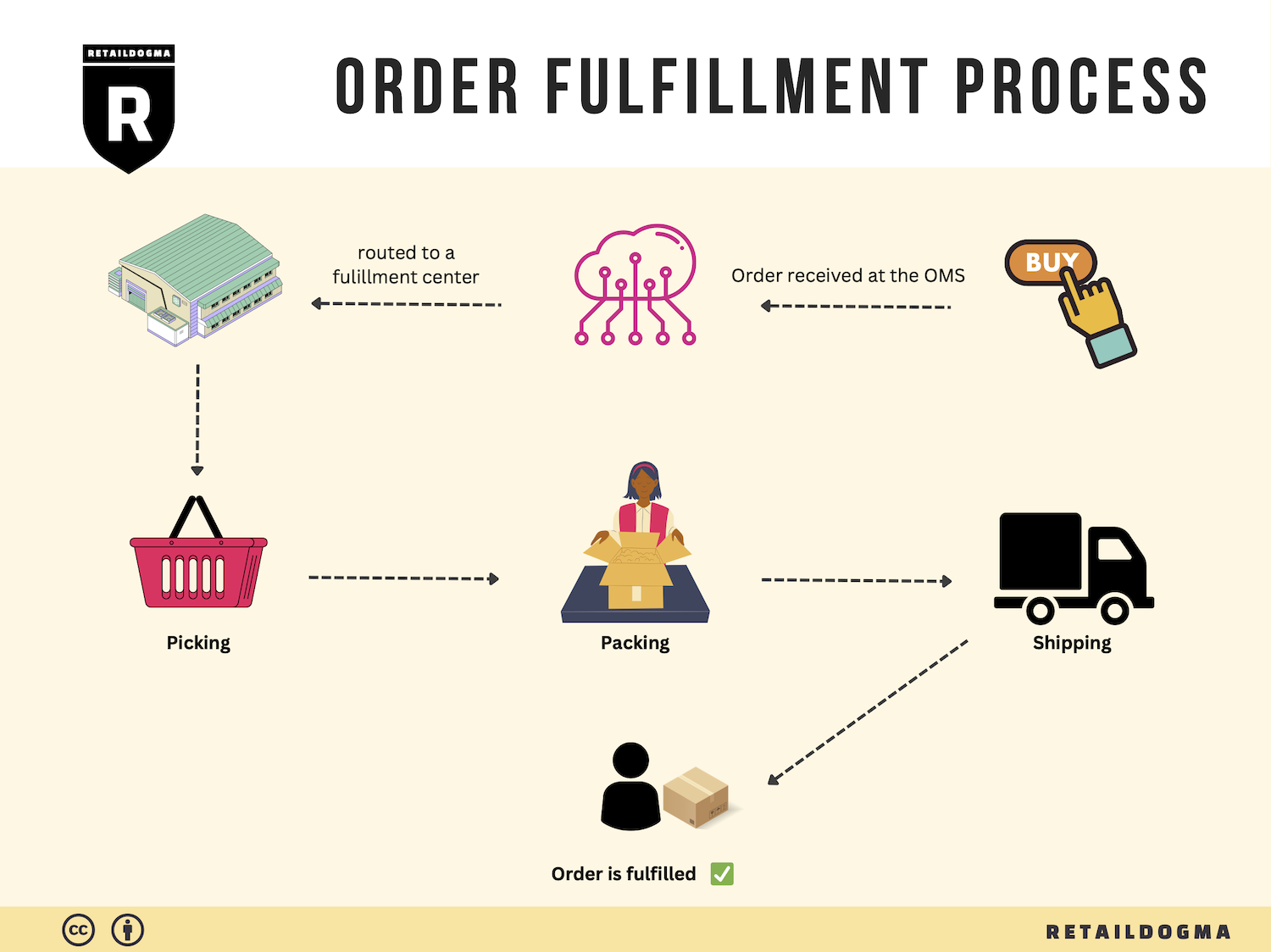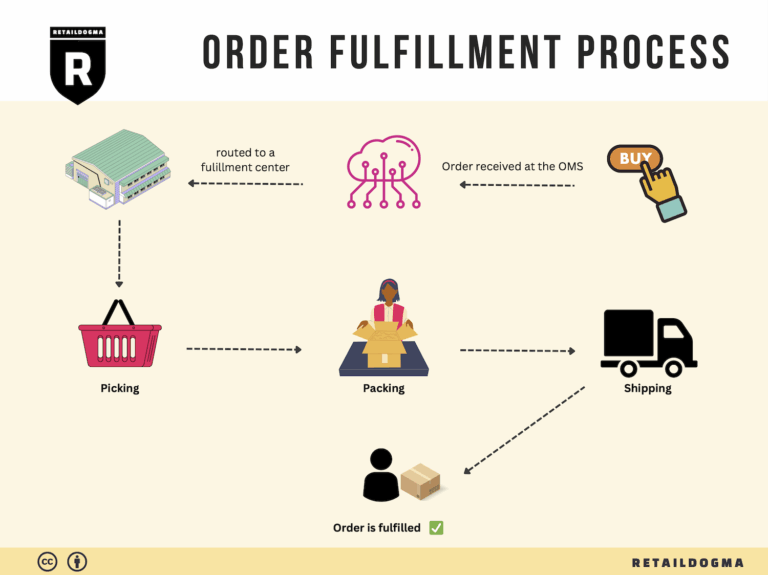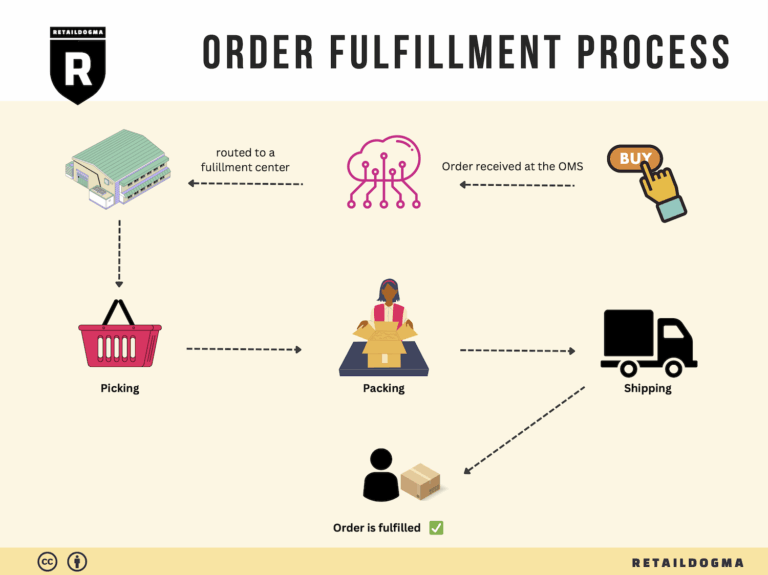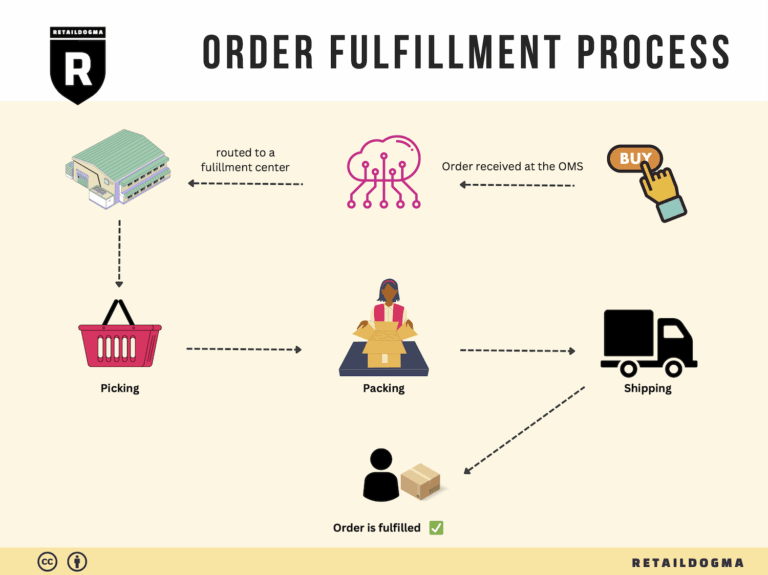Ecommerce Fulfillment Services: The Ultimate Guide (2025)
What is E-commerce Fulfillment? An Introduction for Growing Businesses
Understanding E-commerce Fulfillment for Growing Businesses
As an e-commerce business owner, you may find yourself grappling with the complexities of packing and shipping orders, especially as your sales begin to scale. This crucial yet often overwhelming aspect of operations can distract you from focusing on growth and strategy. The good news is that you don’t have to manage fulfillment alone; understanding the process and available solutions can streamline your logistics and enhance customer satisfaction.
At its core, e-commerce fulfillment is the process of getting a product from your inventory to your customer’s doorstep. This encompasses various activities such as inventory management, order processing, packing, and shipping. As your business grows, the fulfillment method you choose can significantly impact your efficiency and customer experience.
In this guide, we will explore the different fulfillment models available to e-commerce businesses, including third-party logistics (3PL) and Fulfillment by Amazon (FBA). Each model comes with its own set of advantages and challenges, and understanding these can help you align your fulfillment strategy with your business goals.
We will also delve into the core services provided by fulfillment partners, such as inventory storage, order processing, and return management. Knowing what services are essential for your operations will enable you to select a partner that meets your specific needs.
Choosing the right fulfillment partner is crucial. We will outline key factors to consider, such as pricing, service quality, and scalability. A well-chosen partner can not only reduce operational burdens but also contribute to a better customer experience through faster shipping and reliable service.
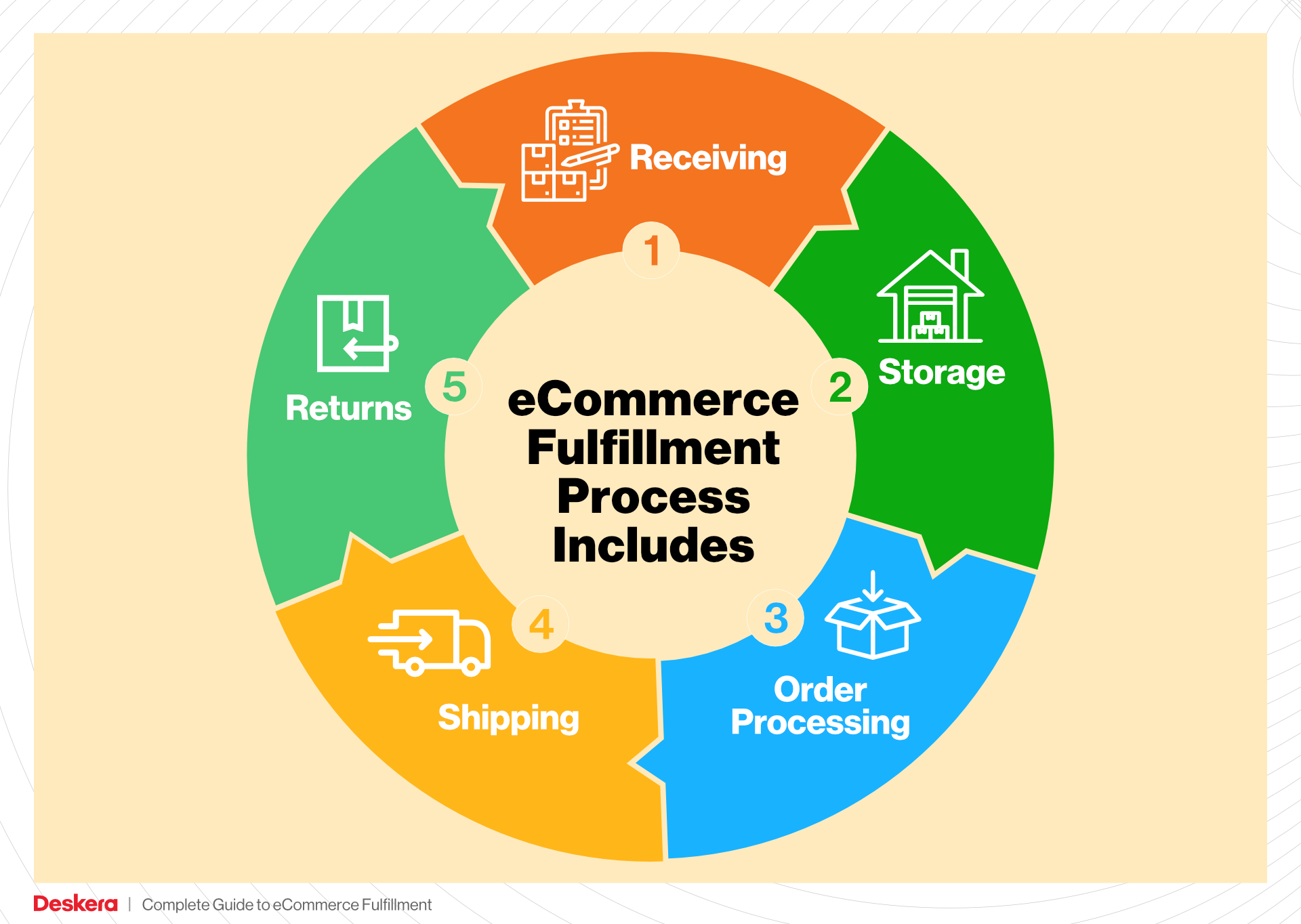
Pricing can be a complex aspect of fulfillment, varying widely based on the services provided, volume of orders, and specific business needs. This guide will help demystify the cost structures associated with different fulfillment options, enabling you to make informed financial decisions.
The ultimate goal of this guide is to empower you, the business owner, to make smart, informed decisions about your logistics. By understanding e-commerce fulfillment and the options available, you can enhance your operational efficiency, improve customer satisfaction, and focus on what matters most—growing your business.
What You’ll Learn In This Guide
- What is E-commerce Fulfillment? An Introduction for Growing Businesses
- The Order Fulfillment Process: From ‘Buy’ Button to Customer’s Door
- Comparing Fulfillment Models: In-House vs. 3PL vs. Dropshipping
- A Deep Dive into Amazon FBA: Pros, Cons, and Who It’s For
- Core Services Offered by Fulfillment Centers
- How to Choose a Fulfillment Partner: A 6-Point Checklist
- Understanding Fulfillment Pricing: A Breakdown of Common Fees
- Frequently Asked Questions (FAQs) about Fulfillment
- Conclusion: Is Outsourcing Fulfillment the Right Move for Your Business?
- Important Disclaimer
The Order Fulfillment Process: From ‘Buy’ Button to Customer’s Door
1. Receiving Inventory
The order fulfillment process begins with receiving inventory from suppliers or manufacturers. This step is crucial as it sets the foundation for all subsequent operations. When inventory arrives, it is essential to verify that the quantities and product specifications match the purchase order. This is typically done using Stock Keeping Units (SKUs), which are unique identifiers assigned to each product.
Accurate receiving helps prevent stock discrepancies that could lead to issues down the line, such as backorders or customer dissatisfaction. Additionally, inspecting incoming goods for damage or defects ensures that only quality products are stored and sold. Proper documentation during this stage, such as packing slips and receiving reports, is also vital for maintaining accurate inventory records and facilitating smooth operations.
2. Warehouse Storage
Once inventory is received and verified, it is moved to the warehouse storage area. Effective warehouse management is key to optimizing space and ensuring that products are easily accessible. This involves categorizing products based on various factors like size, weight, or sales velocity.
The use of inventory management systems (IMS) plays a significant role here. These systems help track inventory levels, manage stock locations, and prevent overstocking or stockouts. Proper storage not only improves efficiency when picking orders but also minimizes the risk of damage or loss. An organized warehouse reduces the time and labor costs associated with locating items, thereby enhancing overall fulfillment speed.
3. Order Picking
Order picking is the process of retrieving items from warehouse storage to fulfill customer orders. This step is pivotal, as it directly impacts order accuracy and customer satisfaction. Businesses often employ pick lists, which are documents that outline the items needed for each order, including quantities and locations within the warehouse.
There are various picking methods, such as single order picking, batch picking, and wave picking, each suited for different business models and order volumes. The effectiveness of the picking process can significantly affect delivery times. By optimizing routes and employing technology such as barcode scanners or RFID systems, businesses can reduce picking errors and enhance efficiency. Accurate picking ensures that customers receive the correct items, which is vital for maintaining trust and loyalty.
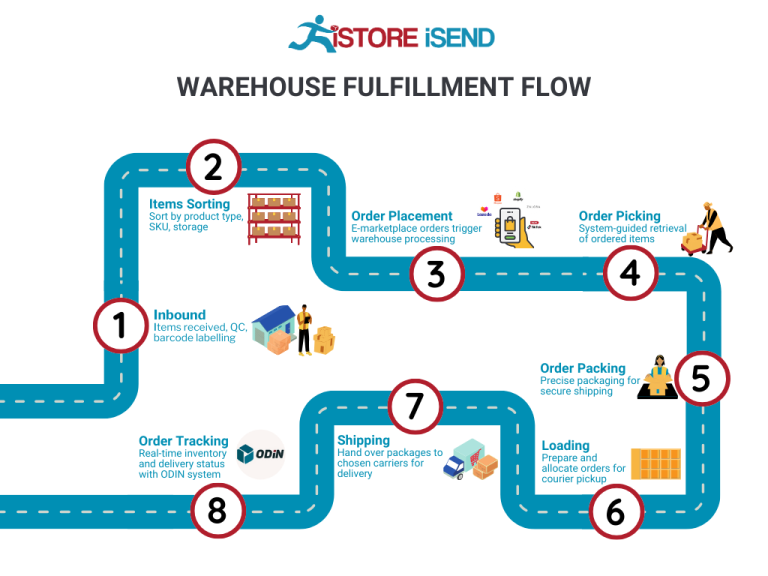
4. Order Packing
After items are picked, the next step is order packing. This is where products are prepared for shipment, and it is essential to ensure that items are securely packaged to prevent damage during transit. Proper packing techniques, such as using appropriate materials (e.g., bubble wrap, foam peanuts) and labeling, are crucial for safeguarding products.
Packing slips, which include order details and return instructions, should be included with the shipment. This step is not just about protection; it also reflects your brand’s professionalism. Investing in branded packaging can enhance the unboxing experience, making it more memorable for customers. Efficient packing processes can also reduce shipping costs by minimizing package size and weight, which is beneficial for the overall bottom line.
5. Shipping & Delivery
The final step in the order fulfillment process is shipping and delivery. This involves selecting the best shipping carrier based on cost, speed, and reliability, and then dispatching the packages to customers. Timely shipping is a critical factor in customer satisfaction, as most consumers expect prompt delivery after placing an order.
Shipping management software can help streamline this process by comparing rates from various carriers and providing tracking information. Additionally, understanding shipping terms such as “last-mile delivery” is vital, as this is the final leg of the shipping journey and often the most challenging. Efficient shipping and delivery not only enhance customer experiences but also contribute to repeat business and brand loyalty.
In conclusion, mastering the order fulfillment process is essential for e-commerce businesses looking to scale. Each step—from receiving inventory to shipping and delivery—plays a crucial role in ensuring operational efficiency and customer satisfaction. By optimizing these processes, businesses can reduce costs, improve order accuracy, and ultimately drive sales growth.

Comparing Fulfillment Models: In-House vs. 3PL vs. Dropshipping
Fulfillment Model Comparison
| Model | Who Handles Inventory | Best For (Business Stage) | Key Advantage | Key Disadvantage |
|---|---|---|---|---|
| In-House Fulfillment | The business itself | Startups and small businesses | Full control over inventory and fulfillment process | High overhead costs and resource intensive |
| Third-Party Logistics (3PL) | A third-party provider | Growing and scaling businesses | Cost-effective and scalable fulfillment solutions | Less control over inventory management and shipping |
| Dropshipping | Supplier or manufacturer | New or niche businesses | Low upfront costs and no inventory holding | Limited control over shipping speed and quality |
In-House Fulfillment
In-house fulfillment is the model where a business manages its own inventory and the entire order fulfillment process. This approach is often adopted by startups and small businesses that require a high degree of control over their operations. By handling everything from storage to packaging and shipping, businesses can tailor the fulfillment experience to meet their specific needs and maintain direct communication with customers. The primary advantage of in-house fulfillment is the ability to manage inventory closely, ensuring that stock levels are accurately maintained and orders are fulfilled promptly. This model also allows for personalized customer service, as business owners can directly address customer inquiries and issues.
However, the in-house model comes with significant drawbacks. The overhead costs can be quite high due to the need for warehousing space, equipment, and labor. As order volumes increase, the complexity of operations can escalate, leading to potential inefficiencies. Additionally, managing logistics can distract business owners from focusing on growth strategies and core business activities. As a result, while in-house fulfillment may be ideal for small businesses, it can become a liability as they scale.
Third-Party Logistics (3PL)
Third-party logistics (3PL) involves outsourcing fulfillment operations to specialized providers who manage inventory, warehousing, and shipping. This model is particularly beneficial for growing and scaling businesses that experience fluctuations in order volume. By partnering with a 3PL, businesses can leverage the provider’s established infrastructure and expertise, which often results in cost savings and improved efficiency. 3PL providers typically have access to advanced technology, allowing businesses to streamline their operations and improve inventory management.
The key advantage of 3PL is the scalability it offers. As a business grows, it can easily adjust its fulfillment capacity without the need for significant investments in warehousing or logistics infrastructure. Additionally, 3PL providers often negotiate better shipping rates due to their volume, which can lead to lower shipping costs for the business. However, the downside is the reduced control over inventory and fulfillment processes. Businesses may find it challenging to monitor their stock levels and may face delays if the 3PL provider experiences issues. Furthermore, relying on an external partner can introduce risks related to service quality and customer satisfaction.
Dropshipping
Dropshipping is a fulfillment model where the retailer does not hold inventory but instead forwards customer orders to a supplier or manufacturer, who then ships the products directly to the customer. This model is especially appealing for new or niche businesses that wish to minimize upfront costs and avoid the complexities of inventory management. By eliminating the need to purchase and store inventory, entrepreneurs can focus on marketing and customer acquisition without the financial burden of stocking products.
The primary advantage of dropshipping is the low barrier to entry. Entrepreneurs can start their businesses without significant capital investment, making it easier to test new products and market ideas. Additionally, dropshipping provides flexibility, as businesses can easily pivot or expand their product offerings without the logistical constraints of traditional inventory management. However, there are notable disadvantages, including limited control over shipping times, product quality, and customer service. Because the retailer relies on third parties for fulfillment, delays or errors can lead to customer dissatisfaction, which ultimately affects the retailer’s brand reputation. Furthermore, profit margins can be thinner due to reliance on suppliers, which may limit the potential for scaling the business effectively.
Conclusion
Choosing the right fulfillment model is critical for e-commerce businesses looking to scale. Each model—In-House Fulfillment, 3PL, and Dropshipping—has its own set of advantages and disadvantages that must be carefully considered based on the specific needs, growth stage, and resources of the business. By understanding the nuances of each model, e-commerce entrepreneurs can make informed decisions that align with their operational goals and customer expectations.
A Deep Dive into Amazon FBA: Pros, Cons, and Who It’s For
Understanding Fulfillment by Amazon (FBA)
Fulfillment by Amazon (FBA) is a service that allows e-commerce sellers to store their products in Amazon’s fulfillment centers. Amazon takes care of storage, packaging, and shipping of the products directly to the customer. This service is particularly beneficial for sellers looking to leverage Amazon’s vast logistics network and customer base, allowing them to scale their operations quickly and efficiently.
How FBA Works
-
Inventory Preparation: Sellers prepare their products for shipment to Amazon’s fulfillment centers. This includes labeling and packaging products according to Amazon’s guidelines.
-
Shipping to Amazon: After preparing the products, sellers send their inventory to Amazon’s warehouses. Amazon provides tools to help sellers determine where to send their inventory based on demand and shipping costs.
-
Storage: Once the products arrive at Amazon’s fulfillment centers, they are stored until a customer places an order. Amazon handles all aspects of storage, ensuring that the inventory is safe and organized.
-
Order Fulfillment: When a customer orders a product, Amazon picks, packs, and ships the item on behalf of the seller. Customers benefit from quick shipping options, including Amazon Prime.
-
Customer Service and Returns: Amazon also manages customer service for FBA orders, handling inquiries, returns, and refunds, which frees sellers from these responsibilities.
Pros of Fulfillment by Amazon (FBA)
1. Prime Eligibility
One of the most significant advantages of using FBA is that products become eligible for Amazon Prime. This status attracts millions of Prime members who prefer to shop for items with fast, free shipping. As a result, sellers can see an increase in sales due to the higher visibility and appeal of Prime-eligible products.
2. Customer Trust
Amazon is a well-established brand with a strong reputation for reliability and customer service. When sellers use FBA, they benefit from the trust associated with Amazon. Customers are more likely to purchase products fulfilled by Amazon because they know they will receive their orders promptly and can easily return items if necessary.
3. Multi-Channel Fulfillment
FBA is not limited to just Amazon sales. Sellers can use FBA to fulfill orders from other channels, such as their own websites or other marketplaces. This flexibility allows businesses to streamline their logistics and maintain consistent service levels across various sales platforms.
4. Scalable Operations
FBA allows sellers to scale their operations without the need to invest heavily in warehousing or logistics. As sales grow, sellers can send more inventory to Amazon, allowing them to focus on marketing and product development rather than order fulfillment.
5. Advanced Logistics
With FBA, sellers can leverage Amazon’s advanced logistics network, including optimized shipping routes and efficient inventory management systems. This ensures that products are delivered quickly and cost-effectively.
Cons of Fulfillment by Amazon (FBA)
1. High Fees
While FBA offers numerous benefits, the associated costs can be significant. Sellers incur storage fees for keeping their inventory in Amazon’s warehouses, as well as fulfillment fees based on the size and weight of the products. These fees can eat into profit margins, especially for low-cost items.
2. Strict Inventory Rules
Amazon has stringent rules regarding inventory management, including how products should be packaged and labeled. Non-compliance can lead to penalties, additional fees, or even the removal of products from the platform. Sellers must invest time and resources to ensure they meet these guidelines.
3. Commingling Risks
FBA has a commingling policy that allows Amazon to pool inventory from multiple sellers. While this can simplify logistics, it also poses risks. If another seller’s product is defective or damaged, it may affect your inventory, leading to customer complaints and potential returns that are not your fault.
4. Limited Control Over Branding
Sellers using FBA have less control over the packaging and presentation of their products. Amazon handles the packing process, which may not align with a seller’s branding strategy. This can dilute the brand experience for customers.
5. Dependency on Amazon
Relying on FBA means that sellers are subject to Amazon’s policies and changes. Any shifts in Amazon’s fee structure, fulfillment processes, or policies can directly impact a seller’s business operations and profitability.
Who is FBA Best For?
Fulfillment by Amazon is particularly advantageous for:
-
New Sellers: Entrepreneurs starting their e-commerce journey can benefit from Amazon’s established infrastructure and customer base without needing to invest in logistics.
-
High-Volume Sellers: Businesses that experience a high volume of orders can scale quickly using FBA’s extensive network, which can handle large quantities of inventory efficiently.
-
Brands Looking for Prime Access: Sellers who want to tap into the Prime customer base and benefit from increased visibility will find FBA highly beneficial.
-
Multi-Channel Sellers: Businesses that sell across various platforms and want to streamline their fulfillment process can leverage FBA for efficient order management.
-
Sellers with Limited Logistics Expertise: Those who lack the knowledge or resources to manage their own fulfillment can rely on Amazon’s expertise to handle logistics and customer service.
In conclusion, while FBA presents a robust solution for many e-commerce businesses, it is essential to weigh the pros and cons carefully. Sellers must ensure that the benefits align with their business goals, operational capabilities, and financial objectives to make the most out of this fulfillment service.
Core Services Offered by Fulfillment Centers
Inventory Management & Warehousing
Inventory management and warehousing are foundational services provided by fulfillment centers, essential for any e-commerce business aiming to scale. This service encompasses the systematic tracking of inventory levels, orders, sales, and deliveries, ensuring that businesses have the right products in stock when needed.
Fulfillment centers utilize advanced inventory management systems to monitor stock levels in real-time, which allows for accurate forecasting and demand planning. This is crucial for e-commerce businesses to avoid stockouts or overstock situations, both of which can lead to lost sales or increased holding costs. With strategically located warehouses, fulfillment centers can store inventory closer to key markets, thereby reducing shipping times and costs.
The benefits of effective inventory management include improved cash flow, as businesses can optimize their stock levels and reduce excess inventory. Additionally, having a reliable warehousing solution enables e-commerce businesses to scale operations seamlessly, accommodating fluctuations in order volume without the need for significant upfront investment in infrastructure. This agility is particularly beneficial during peak seasons or promotional campaigns, ensuring that businesses can meet customer demand efficiently.
Pick and Pack Services
Pick and pack services are critical components of the order fulfillment process. This service involves the selection (or “picking”) of ordered items from the warehouse and their subsequent packaging (or “packing”) for shipment to customers. Fulfillment centers employ efficient picking strategies, such as batch picking or zone picking, to streamline this process and reduce the time taken to fulfill each order.
The primary benefit of pick and pack services is the enhancement of order accuracy and speed. Fulfillment centers leverage technology, such as barcode scanners and automated systems, to minimize human error during the picking process. This results in higher customer satisfaction due to fewer mistakes and faster delivery times.
Moreover, outsourcing pick and pack services allows e-commerce businesses to focus on their core competencies, such as marketing and product development, rather than getting bogged down in logistics. This operational efficiency not only saves time but also reduces labor costs, as fulfillment centers typically operate at a scale that allows for lower per-unit handling costs.
Kitting and Assembly
Kitting and assembly services offered by fulfillment centers provide an efficient way for e-commerce businesses to bundle products or prepare items for sale. This may involve assembling components into a finished product, creating gift sets, or packaging multiple items together for promotional sales.
By utilizing kitting services, businesses can streamline their inventory management and enhance the customer experience. For example, if a business sells a product that requires multiple components, such as a DIY kit, a fulfillment center can assemble these components into a single package before shipping. This not only saves time but also ensures that customers receive everything they need in one shipment, reducing the likelihood of dissatisfaction.
The benefits of kitting and assembly extend to inventory control as well. By pre-packaging items, businesses can better manage their stock levels and reduce the complexity of their inventory. This service can also facilitate promotional efforts by allowing businesses to create special bundles or seasonal offerings that attract customers and increase average order values.
Returns Management (Reverse Logistics)
Returns management, also known as reverse logistics, is a crucial service provided by fulfillment centers that helps e-commerce businesses efficiently handle product returns. This process involves the systematic return of products from customers back to the fulfillment center, including inspection, restocking, and processing of refunds or exchanges.
The effective management of returns is vital in maintaining customer satisfaction and loyalty. A streamlined returns process can minimize the hassle for customers, encouraging them to make future purchases. Fulfillment centers employ technology to track returns, ensuring that products are assessed quickly and accurately, which in turn allows businesses to restock items promptly and reduce losses associated with returns.
Moreover, robust returns management can provide valuable insights into customer behavior and product quality. By analyzing return data, e-commerce businesses can identify trends, such as recurring product defects or reasons for dissatisfaction, enabling them to make informed decisions regarding product improvements or adjustments to their offerings.
In summary, returns management not only enhances the customer experience but also contributes to a business’s bottom line by optimizing inventory turnover and reducing the financial impact of returns. This service is particularly important in today’s e-commerce landscape, where customer expectations for hassle-free returns are increasingly high.
In conclusion, fulfillment centers offer a suite of core services—inventory management and warehousing, pick and pack services, kitting and assembly, and returns management—that are essential for scaling e-commerce operations effectively. By leveraging these services, businesses can optimize their logistics, enhance customer satisfaction, and focus on growth strategies that drive long-term success.
How to Choose a Fulfillment Partner: A 6-Point Checklist
Location & Warehouse Network
The location of your fulfillment partner’s warehouses significantly impacts shipping speed and costs. Strategically placed warehouses can reduce transit times and shipping expenses, enhancing customer satisfaction.
Why It’s Important:
– Proximity to major markets can lead to faster delivery times.
– Reduced shipping costs can improve your bottom line.
Questions to Ask:
1. Where are your fulfillment centers located, and how do they align with my target markets?
2. How do you determine the optimal warehouse locations for my inventory?
3. Do you have a plan for expanding your warehouse network as my business grows?
Technology & Integrations
A robust technology platform is essential for seamless order processing, inventory management, and real-time tracking. Your fulfillment partner should offer easy integration with your existing e-commerce systems.
Why It’s Important:
– Efficient technology minimizes errors and improves order accuracy.
– Real-time data helps you make informed decisions regarding inventory and shipping.
Questions to Ask:
1. What software do you use for order management and inventory tracking?
2. Can your system integrate with my current e-commerce platform (e.g., Shopify, WooCommerce)?
3. Do you provide API access for custom integrations?
Specializations (e.g., cold storage, oversized items)
If your products require specialized handling—such as cold storage for perishables or specific care for oversized items—ensure your fulfillment partner can accommodate these needs.
Why It’s Important:
– Specialized services can prevent damage and ensure compliance with regulations.
– Tailored solutions can enhance customer satisfaction for niche products.
Questions to Ask:
1. What types of specialized fulfillment services do you offer?
2. How do you handle products that require special storage conditions?
3. Can you manage the logistics for oversized or fragile items?
Scalability & Capacity
As your business grows, your fulfillment partner should be able to scale operations to meet increasing demand. Evaluate their capacity to ensure they can handle your future order volumes without compromising service quality.
Why It’s Important:
– A partner that can scale with your business prevents potential bottlenecks.
– Ensures that you can meet peak season demands without switching providers.
Questions to Ask:
1. What is your current capacity, and how do you handle peak seasons?
2. How quickly can you scale your operations if my order volume increases?
3. Are there any limitations on the types of products you can handle as we grow?
Pricing and Contracts
Understanding the pricing structure and contract terms is crucial to avoid unexpected costs. Look for transparency in pricing and flexible contract options that align with your business needs.
Why It’s Important:
– Clear pricing helps you budget effectively and maintain profitability.
– Flexible contracts can accommodate changes in your business model.
Questions to Ask:
1. What are your pricing models (e.g., per order, per item, storage fees)?
2. Are there any additional costs I should be aware of (e.g., returns, handling fees)?
3. What are the terms of your contracts, and is there a minimum commitment period?
Customer Support & Reviews
Reliable customer support is essential for addressing issues that may arise during the fulfillment process. Additionally, researching reviews and testimonials can provide insights into the partner’s reliability and service quality.
Why It’s Important:
– Responsive customer support can resolve issues quickly, minimizing disruptions.
– Positive reviews indicate a partner’s ability to deliver on their promises.
Questions to Ask:
1. What customer support options do you offer (e.g., phone, email, chat)?
2. How quickly can I expect a response to my inquiries?
3. Can you provide references or case studies from businesses similar to mine?
Conclusion
Choosing the right fulfillment partner is a critical decision that can significantly impact your e-commerce operations. By evaluating potential partners against these six key criteria—Location & Warehouse Network, Technology & Integrations, Specializations, Scalability & Capacity, Pricing and Contracts, and Customer Support & Reviews—you can make an informed choice that supports your business’s growth and enhances customer satisfaction. Always remember to conduct thorough due diligence, including site visits when possible, to ensure alignment with your operational needs and business goals.
Understanding Fulfillment Pricing: A Breakdown of Common Fees
Initial Setup Fees
When partnering with a fulfillment service, businesses often encounter initial setup fees. These are one-time charges associated with establishing your account and integrating your inventory into the fulfillment provider’s system. The costs can vary significantly based on the complexity of your needs and the provider’s pricing structure. Typically, you can expect to pay for account setup, software integration, and sometimes even training on using their platform effectively.
Calculating these fees usually depends on the fulfillment partner’s specific processes. Some providers may offer a flat rate, while others might charge based on the volume of products or the number of SKUs you wish to manage. It’s essential to clarify what is included in these fees to avoid unexpected costs.
Receiving Fees
Receiving fees are charged when your inventory is delivered to the fulfillment center. This cost covers the labor required to unload, inspect, and store your products. The fees can vary based on the number of pallets or boxes received and whether there are any special handling requirements (e.g., fragile items).
Fulfillment providers typically calculate receiving fees per pallet or per box. For instance, if you send 10 pallets, and the receiving fee is $20 per pallet, your total receiving fee would be $200. Be sure to understand any additional charges for items that require extra attention or specific handling instructions.
Storage Fees (per pallet/bin)
Storage fees are ongoing charges for keeping your inventory in the fulfillment center. These fees can be calculated on a per-pallet or per-bin basis, depending on how your products are stored. Typically, businesses are charged monthly, and the rate can vary significantly depending on the provider and the geographical location of the warehouse.
For example, if a provider charges $25 per pallet per month and you have 5 pallets stored, your monthly storage cost would be $125. It’s crucial to consider how your inventory turnover rate impacts storage fees; slow-moving products can lead to increased costs. Understanding seasonal variations in your inventory levels can also help you manage storage fees more effectively.
Pick & Pack Fees (per item/order)
Pick and pack fees are incurred each time an order is processed. This fee covers the cost of locating the items in the warehouse, picking them from shelves, packing them for shipment, and preparing them for dispatch. These fees can be structured in different ways, such as a flat fee per order, a fee per item, or a combination of both.
For instance, if the pick fee is $1.50 per item and you have an order of 3 items, your total pick fee would be $4.50. Additionally, some providers may charge a packing fee, which could be a flat rate or vary based on the type of packaging required. Understanding how these fees accumulate is essential for budgeting your fulfillment costs accurately.
Shipping Fees
Shipping fees are among the most variable costs associated with fulfillment. These fees depend on the shipping method chosen (standard, expedited, etc.), the destination of the package, and the weight and dimensions of the items being shipped. Fulfillment providers often have negotiated rates with carriers, which can lead to cost savings compared to retail shipping rates.
Shipping fees can be calculated based on a variety of factors. For instance, if you opt for a standard shipping rate that costs $5 for a package under 2 lbs, but you have a heavier item that costs $12 to ship, your shipping fees will differ significantly based on the items in the order. It’s essential to analyze your shipping strategy—balancing cost and delivery speed can help enhance customer satisfaction without inflating your expenses.
Tips for Getting an Accurate Quote
-
Define Your Needs: Before seeking quotes, clearly outline your fulfillment requirements, including expected order volumes, product dimensions, and special handling needs.
-
Request Detailed Quotes: When approaching fulfillment providers, ask for a breakdown of all potential fees. This ensures you understand what you’re being charged for and helps compare different providers accurately.
-
Inquire About Discounts: Many fulfillment services offer discounts for higher volumes or long-term contracts. Don’t hesitate to negotiate terms based on your projected growth.
-
Consider Hidden Fees: Be vigilant about potential hidden costs, such as fees for returns, inventory audits, or additional packaging materials. Make sure these are included in your quote.
-
Evaluate Flexibility: Choose a fulfillment partner that allows you to scale easily. Flexibility in pricing and services can be crucial as your business grows.
By understanding these various fulfillment pricing models and employing these tips, you can better navigate the complexities of fulfillment costs and make informed decisions that support your business’s growth.
Frequently Asked Questions (FAQs) about Fulfillment
1. What is wholesale fulfillment?
Wholesale fulfillment refers to the process of receiving, processing, and delivering bulk orders from retailers or other businesses rather than individual consumers. This involves managing inventory, packaging products in larger quantities, and coordinating logistics to ensure timely delivery to retail locations or distribution centers.
2. What’s the difference between a warehouse and a fulfillment center?
A warehouse is primarily used for storing products until they are needed, focusing on inventory management. In contrast, a fulfillment center is equipped to handle the entire process of order fulfillment, including picking, packing, and shipping products directly to customers or retailers. Fulfillment centers often have advanced technology for managing orders and inventory efficiently.
3. What is a 3PL (Third-Party Logistics)?
A 3PL, or third-party logistics provider, is a service that manages a company’s logistics and supply chain operations. This includes warehousing, order fulfillment, shipping, and sometimes inventory management. Using a 3PL allows businesses to focus on their core operations while leveraging the expertise and infrastructure of the logistics provider.
4. How much do fulfillment services cost?
The cost of fulfillment services varies widely based on several factors, including order volume, the complexity of operations, storage space required, and specific services needed (like returns management or custom packaging). Generally, costs may include a per-order fee, storage fees, and shipping fees. Businesses should request quotes from multiple providers to find the best fit for their budget.
5. How do I choose the right fulfillment provider for my business?
Choosing the right fulfillment provider involves assessing your business needs, order volume, product types, and desired delivery speed. Key factors to consider include the provider’s location (to minimize shipping times), technology integration capabilities (for inventory management and order tracking), cost structures, and customer service reputation. It’s advisable to conduct thorough research and possibly trial several providers.
6. What are the benefits of outsourcing fulfillment?
Outsourcing fulfillment can lead to significant advantages, including reduced operational costs, access to advanced technology and expertise, scalability during peak seasons, improved shipping times, and enhanced customer service. By leveraging a fulfillment partner, businesses can focus on marketing and sales while ensuring their logistics are handled efficiently.
7. Can I manage my own fulfillment in-house?
Yes, many small to medium-sized businesses manage their own fulfillment in-house, especially when they have lower order volumes or unique product requirements. This approach allows for greater control over the process, but it can become challenging as order volume increases, requiring more space, staff, and resources.
8. What is dropshipping, and how does it relate to fulfillment?
Dropshipping is a fulfillment method where the retailer does not hold inventory but instead forwards customer orders to a supplier or manufacturer, who then ships the products directly to the customer. This model reduces upfront costs and inventory risk, but it can result in less control over shipping times and product quality.
9. How can I improve my fulfillment efficiency?
Improving fulfillment efficiency can be achieved through various strategies, such as optimizing your inventory management system, automating order processing, using technology for real-time tracking, and regularly reviewing and refining your logistics partnerships. Investing in staff training and maintaining clear communication with your fulfillment provider can also enhance overall efficiency.
10. What should I know about international fulfillment?
International fulfillment involves additional complexities, including understanding customs regulations, tariffs, and shipping logistics across different countries. Businesses must ensure compliance with international shipping laws and may need to partner with fulfillment providers that specialize in global logistics. It’s crucial to have a clear strategy to manage lead times and costs associated with international orders.
Conclusion: Is Outsourcing Fulfillment the Right Move for Your Business?
Evaluating the Decision to Outsource Fulfillment
Outsourcing fulfillment can be a transformative decision for e-commerce businesses aiming to scale efficiently. One of the most significant benefits of partnering with a fulfillment service is the time savings it provides. By outsourcing warehousing, inventory management, and shipping logistics, business owners can focus on core activities such as marketing, product development, and customer engagement. This shift not only enhances operational efficiency but also allows for more strategic growth initiatives.
Scalability is another critical advantage of utilizing a fulfillment partner. As order volumes fluctuate, especially during peak seasons, a robust fulfillment service can easily adjust to your needs without the burden of managing additional staff or warehouse space. This flexibility ensures that your business can capitalize on growth opportunities without the typical growing pains associated with increased order fulfillment.
Moreover, fulfillment services bring specialized expertise to the table. Many providers have established relationships with shipping carriers, allowing them to negotiate lower rates and access faster shipping options. Their experience in logistics can lead to improved order accuracy and customer satisfaction, which are crucial for maintaining a competitive edge in the crowded e-commerce landscape.
However, the success of outsourcing fulfillment hinges on selecting the right partner. A misaligned fulfillment service can result in poor inventory management, delays, and ultimately dissatisfied customers. Therefore, it is vital to thoroughly assess potential partners based on their capabilities, technology, and alignment with your business goals.
To determine if a fulfillment partner is the right next step for your business, consider conducting an audit of your current shipping and fulfillment processes. Identify bottlenecks, inefficiencies, and areas where you are losing time and resources. This analysis will provide clarity on whether outsourcing fulfillment can help you streamline operations and support your growth trajectory. Embrace the opportunity to refine your logistics strategy and position your business for long-term success.
Important Disclaimer
⚠️ Important Disclaimer
The information in this guide is for educational purposes. Fulfillment services, pricing, and platform features change frequently. Always conduct your own due diligence and consult with providers directly before making business decisions.
